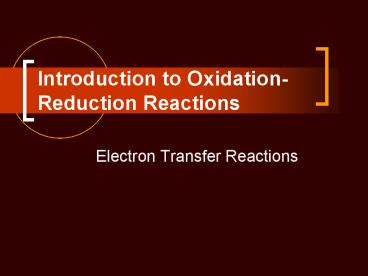Introduction to Oxidation-Reduction Reactions - PowerPoint PPT Presentation
1 / 32
Title:
Introduction to Oxidation-Reduction Reactions
Description:
Introduction to Oxidation-Reduction Reactions Electron Transfer Reactions Types of Chemical Reactions There are four types of chemical reactions: Acid/Base ... – PowerPoint PPT presentation
Number of Views:542
Avg rating:3.0/5.0
Title: Introduction to Oxidation-Reduction Reactions
1
Introduction to Oxidation-Reduction Reactions
- Electron Transfer Reactions
2
Types of Chemical Reactions
- There are four types of chemical reactions
- Acid/Base
- Precipitation/Solubility
- Complex Formation/Complex Dissociation
- Oxidation/Reduction
- Any chemical reaction consists of one (or more)
of these basic categories.
3
Oxidation/Reduction Reactions
- Acid/Base reactions
- involve a donation /acceptance of protons
- Precipitation/ Solubility reactions
- involve a donation/ acceptance of negative charge
- what is being donated and accepted in a redox
reaction?
4
Oxidation/Reduction Reactions
- Electrons!
- Consider the reaction taking place in a
disposable battery 2Zn 3MnO2 ? Mn3O4
2ZnOHow can you tell that electrons are being
donated and accepted? Which species is donating
electron( s) and which is accepting electron (s)?
5
REDOX REACTIONS
- Redox reactions are characterized by ELECTRON
TRANSFER between an electron donor and electron
acceptor.
6
REDOX REACTIONS
- Transfer leads to
- increase in oxidation number of some element
OXIDATION - 2. decrease in oxidation number of some element
REDUCTION
7
Electron Transfer in Redox Reactions
- Oxidation
- Loss of electrons
- Gain in oxygen
- Reduction
- Gain of electrons
- Loss of oxygen
- LEO the lion goes Ger
8
Example
- The reaction of a metal and non-metal
- All the electrons must be accounted for!
Mg
S
Mg 2
S2-
?
9
Oxidation-Reduction
- Oxidation means an increase in oxidation state -
lose electrons. - Reduction means a decrease in oxidation state -
gain electrons. - The substance that is oxidized is called the
reducing agent. - The substance that is reduced is called the
oxidizing agent.
10
Assigning Oxidation States
- An Oxidation-reduction reaction involves the
transfer of electrons. - You should memorize these rules
11
Rules for Oxidation States
- The charge the atom would have in a molecule (or
an ionic compound) if electrons were completely
transferred. - The oxidation state of elements in their standard
states is zero. - Example Na, Be, K, Pb, H2, O2, P4 0
12
Assigning Oxidation States
- Oxidation state for monatomic ions are the same
as their charge. - Example Li, Li 1 Fe3, Fe 3 O2-, O
-2 - Oxygen is assigned an oxidation state of -2 in
its covalent compounds except as a peroxide.
13
Rules for Oxidation States
- The oxidation number of hydrogen is 1 except
when it is bonded to metals in binary compounds.
In these cases, its oxidation number is 1. - Group IA metals are 1, IIA metals are 2 and
fluorine is always 1. - The sum of the oxidation numbers of all the atoms
in a molecule or ion is equal to the charge on
the molecule or ion.
14
Practice in Oxidation States
- Assign the oxidation states to each element in
the following. - K2SO4
- NO3-
- H2SO4
- Fe2O3
- Fe3O4
15
Identify the
- Oxidizing agent
- Reducing agent
- Substance oxidized
- Substance reduced
- On the worksheet
16
Types of Oxidation-Reduction Reactions
Combination Reaction
0
0
4
-2
Decomposition Reaction
1
5
-2
1
-1
0
17
Types of Oxidation-Reduction Reactions
Displacement Reaction a.k.a Single Replacement
0
1
2
0
Hydrogen Displacement
0
4
0
2
Metal Displacement
0
-1
-1
0
Halogen Displacement
18
The Activity Series for Metals
Hydrogen Displacement Reaction
M is metal BC is acid or H2O B is H2
19
Copper Demonstration
- Copper Pennies reacting with nitric acid.
- Can you figure out the equation?
20
Types of Oxidation-Reduction Reactions
Disproportionation Reaction
Element is simultaneously oxidized and reduced.
1
-1
0
21
(No Transcript)
22
Half-Reactions
- All redox reactions can be thought of as
happening in two halves. - One produces electrons - Oxidation half.
- The other requires electrons - Reduction half.
23
Half-Reactions
- Write the half reactions for the following.
- Na Cl2 ? Na Cl-
- SO3- H MnO4- ? SO4- H2O Mn2
24
Balancing Redox Equations
- In aqueous solutions the key is the number of
electrons produced must be the same as those
required. - For reactions in acidic solution an 8 step
procedure.
25
Balancing Redox Equations
- Write separate half reactions
- For each half reaction balance all reactants
except H and O - Balance O using H2O
26
Acidic Solution
- Balance H using H
- Balance charge using e-
27
Acidic Solution
- Multiply equations to make electrons equal
- Add equations and cancel identical species
- Check that charges and elements are balanced.
28
Practice
- Balance the following reactions
- Sn 2 (aq) 2Fe 3 ? Sn 4 (aq) 2Fe 2
- MnO4- (aq) C2O4-2 (aq) ? Mn2 (aq) CO2 (g)
29
Practice
- The following reactions occur in aqueous
solution. Balance them - Cr(OH)3 OCl- OH- CrO4-2 Cl- H2O
- MnO4- Fe2 Mn2 Fe3
30
Now for a tough one
- Fe(CN)6-4 MnO4- Mn2 Fe3 CO2 NO3-
31
Basic Solution
- Do everything you would with acid, but add one
more step. - Add enough OH- to both sides to neutralize the H
- CrI3 Cl2 CrO4- IO4- Cl-
- CN- MnO4- ? CNO- MnO2
32
Redox Titrations
- Same as any other titration.
- the permanganate ion is used often because it is
its own indicator. MnO4- is purple, Mn2 is
colorless. When reaction solution remains clear,
MnO4- is gone. - Chromate ion is also useful, but color change,
orangish yellow to green, is harder to detect.































